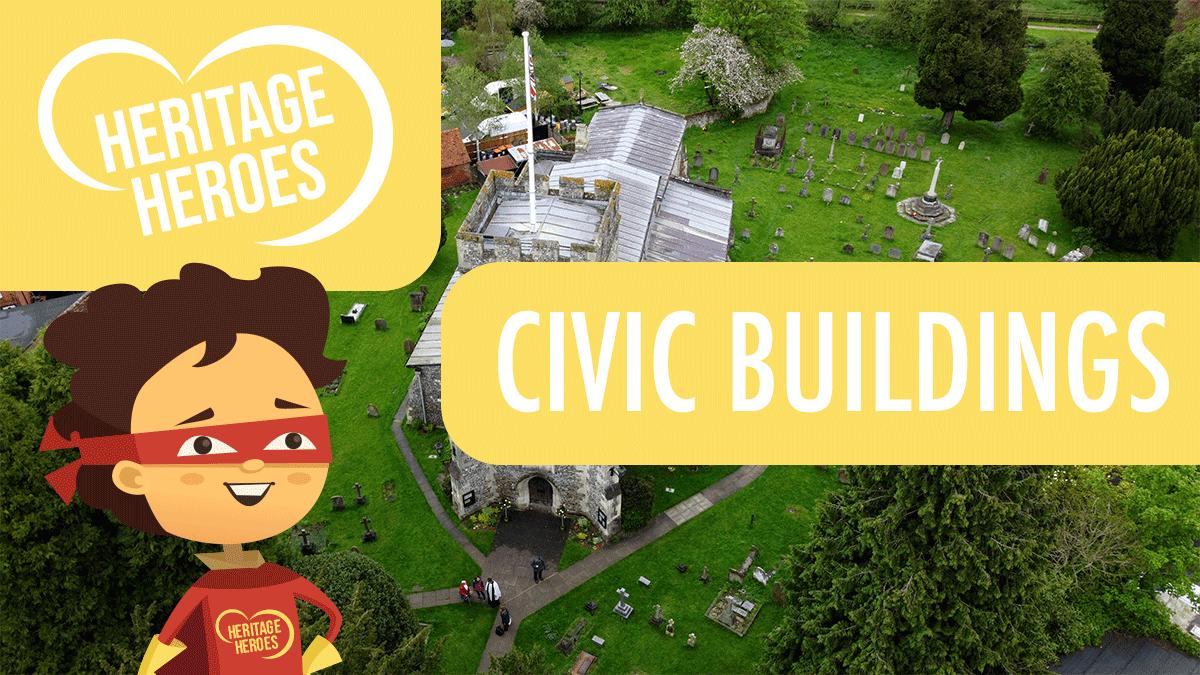Wherever you live, there’s treasure to be discovered!
Not just gold and gems, but stories of buildings, locations and people.
Our heritage is a great wealth… and it’s all around us. Sometimes standing proud in the open air – sometimes hidden behind some bushes.
And to help find it, we’re looking for Heritage Heroes – could you be one?
You can find clues in all sorts of places to find out what happened in your street, neighbourhood and further afield, from famous visitors to historic events.
Here are three tips to help you become a Heritage Hero…

HERITAGE HEROES. AN INSPIRING AUDIO PRODUCTION FOR FUN KIDS. MADE POSSIBLE WITH THE NATIONAL LOTTERY HERITAGE FUND, WITH THANKS TO NATIONAL LOTTERY PLAYERS.
Places of Worship
Places of worship aren’t just churches, they also include temples, mosques and synagogues.
Did you know that there’s over 40,000 places of worship across the UK and in almost every village, town and city. 8,000 of these were built in Medieval times… or earlier!
Like the oldest church in the UK was built in the year 597 – it’s called St Martin and is in Canterbury. The oldest part was built during the Roman occupation. The east end of St Martin’s was extended in the 12-13th centuries and substantially altered in the 19th century. The church tower was added in the 14th century. It has three bells, the largest of which was made in 1393.
There’s a wealth of heritage to be found across all faiths.
The first British synagogue was established in Guildford High Street in the 12th century, whilst Bevis Marks Synagogue in London was built in 1701 and is the oldest synagogue building in the UK in continuous use.
The first purpose-built mosque opened in 1889 – the Shah Jahan Mosque is in Oriental Road, Woking.
You can often find out the age of a church from its design.
Over the centuries, the style of churches has changed – from Saxon with rounded arches and tall narrow doorways to Early English with pointed arches to Victorian gothic revival with picturesque steep gabled roofs and porches.
Why not visit a place of worship and see if you can work out how old it is from its design?
You might also get some clues from gravestones and crypts, which can also tell you about the people who lived nearby.
And don’t forget look at any memorials marking local events or a war.
Civic Buildings
Lots of towns and cities experienced massive growth in population during the 19th century as a result of the industrial revolution, and civic pride motivated many to build some of the great buildings that we still have today.
Town halls are centres of local government. Before the 19th century, they might have been known by a variety of other names including guild hall, shire hall, vestry hall and moot hall.
Town and City Halls are the seat of local government administration. As well as home to the council, they’re often home to the mayor. For many, they symbolize the power and authority of local government and were built in architectural styles popular at the time of their construction. The golden age of town hall construction was in the Victorian and Edwardian periods and the UK has many fine examples – like Manchester City Hall.
Today, some councils are moving out of their old buildings to newer premises, and the historic buildings are finding new uses as concert, conference and wedding venues and even film sets!
Acton Town Hall in West London opened in 1910, was extended in the 1930s and in 2018 was converted to residential use.
Barking Town Hall in East London was built in Neo-Georgian style and its design is based on Stockholm City Hall in Sweden; it opened in 1958 after delays due to World War II.
Havering Town Hall in Romford began as Romford Town Hall and opened in 1937. Restored and redecorated in 2017, the building is constructed in brick and stone with some wonderful oak-panelled chambers within.
Birmingham Town Hall was built in 1832 as a site for concerts, readings and other kinds of public assemblies – and still is today. Now, you might be forgiven for thinking you are in Rome or Greece as it was modeled on the Temple of Castor and Pollux in ancient Rome. It’s a classic example of Corinthian architecture, the third and last style of ancient architecture from Greece and Rome.
Belfast City Hall dates from 1906, was designed by Sir Alfred Brumwell Thomas in the Baroque Revival style and is built in Portland Stone.
As well as town halls, councils often also built grand libraries, which aren’t just great for books – they often have stacks of information about local history – maps, photographs and old newspapers..
Civic buildings also include art galleries and museums.
By checking out their design, we can get clues to when they were built and about the wealth of the town or city. The richer the place – the grander the hall!
You might be able to find out the history of these halls by asking the staff who run them if there’s any documents or old photos to look at.
If you live in a village, check out your village hall – Many were built after the First World War for people to gather, mourn the lost as well as hold social gatherings so that people could look towards the future.
Why don’t you have a go at drawing some of the historic buildings in your local area?
Don’t forget to include how old they are and why they are so special!
Can you find out if it is a listed building?
Why not add symbols of your local area to the drawing? For example if you’re in Manchester you could add a bee!
Historic Buildings
There are many other historic buildings then just museums!
Some of them are built by local authorities and touched the lives of everyday people – from old post offices and post boxes to fire and police stations, and even courts and jail houses.
Many important historic buildings are listed – this means they can’t be damaged or changed – and you can visit some of them.
Go online to historicengland.org.uk to search for listed buildings in your area.
Now it’s over to you! Here’s a reminder of things to look for to help you find out about the place where you live.
1 – Visit a place of worship – how old is the building and what can you find out about your area’s heritage from the graveyard and what’s inside? Make a sketch and a note of any interesting people mentioned on the memorials. What did they do?
2 – Explore your local Civic Buildings and check out their history. Many will be built of local materials or be decorated with local crafts.
3 – And see if you can find a historic building that’s NOT a stately home! You can find clues in the local history resources in your library or online.
Here are some helpful links that will help you become a Heritage Hero!
Old maps: www.townmaps.history.ac.uk/
Historic Houses: www.heritagegateway.org.uk
Churches: www.churches-uk-ireland.org
Civic buildings: www.lovemytown.co.uk/civicpride









